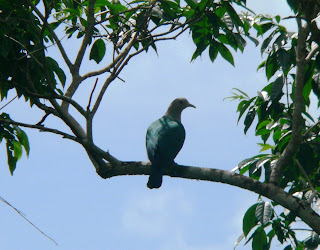During our trip last month to the Lesser Sundas we saw all the endemics and regional specialties on Flores and Komodo islands. This is a White-rumped Kingfisher which perched roadside on our first full day on Flores near the village of Pagal. Thanks to Barbara De Witt for this and some of the other images here.
We had large numbers of Flores Lorikeet in an area of flowering eucalypts during our drive from Labuan Bajo to Ruteng. This is a recent split from the Rainbow Lorikeet, which it closely resembles in habits and call.
Flores (Little) Minivet proved to be one of the more numerous endemics on Flores. We found it at all elevations in good numbers.
The stunning Flame-breasted Sunbird put on a good show for us on Flores, especially at Potawangka. We also had this species frequently on Sumba Island. It is one of the peculiarities of island zoogeography that bird distributions are not consistent; the Lesser Sundas are a good case in point. Flame-breasted Sunbird, for instance, occurs on Timor and Flores, but not on Timor. Other species occur on Timor and Sumba but not on Flores, or Flores and Timor but not on Sumba - and some are on all three.
We thought initially that this raptor flying over us at Potawangka was a Flores Hawk-Eagle but subsequently settled on immature White-bellied Sea-Eagle-Eagle, the young of which in Asia are evidently much whiter on the underparts than in Australia.
Apart from its dragons, Komodo Island is one of the easiest places to see Green Junglefowl.
And certainly Komodo is the top site for Yellow-crested Cockatoo, a species which has suffered severely at the hands of illegal trappers. This bird appeared from a tree crevice as we were searching for Komodo Dragon.
Barred Dove, a close relative of Australia's Peaceful Dove, is another Lesser Sundas specialty which was easy to see on Komodo Island.
Green Imperial-Pigeon, while more widespread, was also common on Komodo.
As was Large-billed Crow. See here for further notes.
We had large numbers of Flores Lorikeet in an area of flowering eucalypts during our drive from Labuan Bajo to Ruteng. This is a recent split from the Rainbow Lorikeet, which it closely resembles in habits and call.
Flores (Little) Minivet proved to be one of the more numerous endemics on Flores. We found it at all elevations in good numbers.
The stunning Flame-breasted Sunbird put on a good show for us on Flores, especially at Potawangka. We also had this species frequently on Sumba Island. It is one of the peculiarities of island zoogeography that bird distributions are not consistent; the Lesser Sundas are a good case in point. Flame-breasted Sunbird, for instance, occurs on Timor and Flores, but not on Timor. Other species occur on Timor and Sumba but not on Flores, or Flores and Timor but not on Sumba - and some are on all three.
We thought initially that this raptor flying over us at Potawangka was a Flores Hawk-Eagle but subsequently settled on immature White-bellied Sea-Eagle-Eagle, the young of which in Asia are evidently much whiter on the underparts than in Australia.
Apart from its dragons, Komodo Island is one of the easiest places to see Green Junglefowl.
And certainly Komodo is the top site for Yellow-crested Cockatoo, a species which has suffered severely at the hands of illegal trappers. This bird appeared from a tree crevice as we were searching for Komodo Dragon.
Barred Dove, a close relative of Australia's Peaceful Dove, is another Lesser Sundas specialty which was easy to see on Komodo Island.
Green Imperial-Pigeon, while more widespread, was also common on Komodo.
As was Large-billed Crow. See here for further notes.










Greg, are you sure about your hawk-eagle? it looks a lot like a White-bellied Sea-eagle to me.....
ReplyDeleteTom
Tom, We did have a discussion about that at the time. I am aware that the tail in this picture looks better for sea-eagle than hawk-eagle and I was concerned that the picture appeared to reflect a broad dark trailing edge. However, I suspect the trailing edge effect is shadow. The key point was that the bird showed no sign of dihedral as it soared over the rainforest. However I'm open to further suggestions.
ReplyDeleteAnother point is that as the bird flew over us, it appeared all white underneath except for broad black primary tips. There was none of the smudgy brown usually seen in immature sea-eagles (the bird was clearly not an adult sea-eagle).
ReplyDeleteAfter a good deal of discussion, we're settled that the bird was in fact likely to be a second-year White-bellied Sea-Eagle, the young of which in Asia are evidently much paler than in Australia.
ReplyDelete